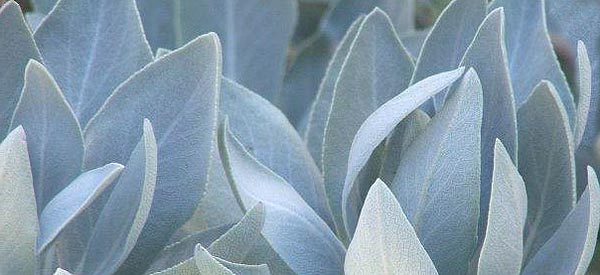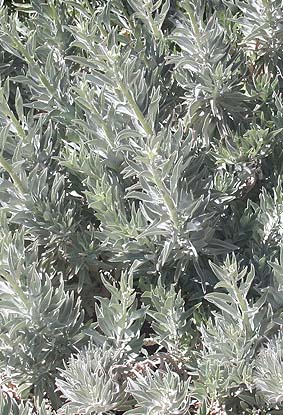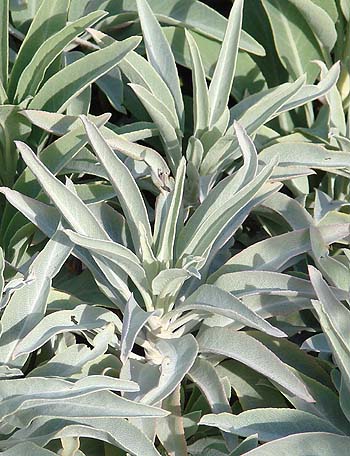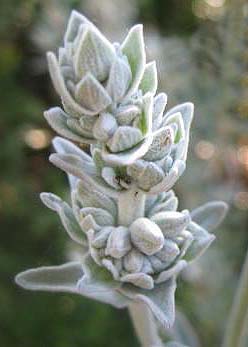A truly beautiful plant. Dramatic resinous silver gray/blue foliage and tall flower spikes up to 9 feet (274 cm) in height. This desert plant loves heat and little water. Its totally at home in those areas where little else will grow because its hot and dry. It does not like a lot of water and cant take humidity so its not for everyone. It also does not like cold but it makes a magnificent pot plant that can be dragged into the garage for the winter months. The shining silvery foliage glistens in the moonlight making it wonderful for moon gardens. While not the easiest plant to grow from seed its certainly worth it. If you use smug sticks making your own from this magnificent plant will help reduce the increasing pressure on the few remaining wild plants, the harvesting of which is not sustainable. Grow your own and enjoy the plant while you do so.
Description of White sage (Salvia apiana).
A tender perennial plant hardy to zone 8, possibly 7. This beautiful plant grows
into a squat bush to small shrub anywhere from 3-5 feet (94-152 cm) high and
from 4 - 6 feet (121-182 cm) wide. The leaves are beautiful silvery gray in
color and lanceolate in shape and finely scalloped or crenulate edges. Leaves
are covered in fine hairs and are more gray green on the top surface and whitish
on the bottom and 1 ½ - 3" (4-8 cm) long and grow in florets at
the top of long stems. In early summer they send up tall upright stems of small
flowers that are either white to pale lavender in color and may reach up to
9 feet (274 cm) high. Flowers bloom a few at a time and can last two months
or more. Flowers are followed in early autumn my small shiny brown nut like
seeds. The whole plant has a strong sage like odor that is more sticky and resinous
that most members of the sage family.
Growing White sage (Salvia apiana) from Seed.
White sage is not the easiest plant to grow from seed. To begin with the germination
rate tends to be quite low, around 15-20% will germinate rapidly. The rest will
wait. This is a survival tactic of desert plants to ensure that some plants
are always around to grow. It works well in the wild but is annoying to the
gardener. Add to that the seeds have a strong coating that helps inhibit germination!
Thus special tactics need to be employed.
First scarify the seeds. This can be done in one of two ways. Either
rub them on sandpaper to scuff up the surface of the seeds. The best way to
do this is:
Take a sheet of rough sandpaper place this on a flat strong surface.
Put a few of the seeds on the sandpaper. Don't use too many at a time you wont
be able to handle them all at once.
Take a sanding sponge. You can buy these in all home improvement stores. Its
basically a tough spongy material covered in sandpaper. Get a course one.
Rub the sponge across the seeds on the sandpaper. The seeds will dig into the
sponge and be dragged across the sandpaper sheet removing some of the outer
coating.
This method works much better than two sandpaper sheets as the seeds tend to
shoot away or ping off all over the room. The sponge keeps them under control
and removes material from the seed at the same time.
Only remove a little of the material don't take the whole seed coat off.
There are some reports that washing the seeds using some mesh material, or a very fine mesh sieve then leaving them to sit for a while then washing again also works to get the coating off. Don't let the seeds sit in water, just rinse them.
We have tried both methods and find the sandpaper works better. Its also faster so you don't have to wait around as long.
Once the seeds are scarified they can be planted.
Seeding outdoors.
This is the simplest method but is only useful in zones 7b and warmer. Higher
zones cannot overwinter White sage outside and need to bring it in or protect
it during the winter months. This method can also be frustrating over time since
the seeds tend to germinate erratically it might be two years before some of
them germinate. During this time you need to keep the weeds off the area where
the sage is to grow, taking care not to pull out any seedlings that might arise.
For more control its best to start the seeds in trays.
Seeding in trays or pots.
Because white sage is such an erratic germinator be prepared to have your seed
trays around for a couple of years. For this reason we recommend that you sow
either in individual cell trays or small pots. Use fairly large cells about
1" across.
After scarifying the seeds plant in a sandy potting mix. The ones sold for cactus
is ideal
or you can make your own using play sand and adding about 25% potting
mix.
Plant 2-3 seeds per cell. Then very lightly cover the seeds. Just a dusting
of sand is ideal. Some sources state the seeds need light to germinate others
do not, so we like to play safe and add just a tiny amount.
Water the mix thoroughly. After that keep the mix just moist but never wet, wet soil will quickly rot the seeds. Place in a warm area in sunshine or under lights. Keep the temperature at 70-75° F ( °C) higher is good but never let the temperature of the soil drop below 70°F (21°C). Some of your seeds should then germinate within 2-3 weeks.
Once these seeds have reached the three leaf stage transplant them from the cell or if in pots let them grow larger. Keep plants in pots until large enough to plant out. Taking care to harden plants off first.
The rest of the tray should be kept moist and warm. Be patient, don't throw
it away. It is best to keep it inside or in the greenhouse if possible. Taking
it outside will encourage weed seeds to land and grow making the germination
harder. Keep it moist and wait. As seedlings appear transplant them out. When
winter comes the tray can be brought into the house or left in a warm greenhouse.
Keep moist. If no more seedlings have arisen by the following summer then empty
the seed mix onto some ground where you would like the sage to grow and forget
it. Some of the seeds may still germinate. We have had some arise after three
years.
Do not place the tray outside in the winter or dump seeds outside in zones 7a
or above. The plants will not survive the cold.
Location and Care of White sage (Salvia apiana).
White sage is a desert plant so it will not grow well in humid conditions. It
needs a sandy well drained soil and very little water. It is ideal for hot sunny
locations where little else will grow. Most likely not suited for southeastern
US unless location is chosen very carefully.
Will not tolerate shade. Shade and moisture make it prone to mildews.
If your locations allows white sage can be planted anywhere there is plenty of sunshine and not a lot of water. Giving it a few drops now and again will help but once its established it wont need much help.
While white sage can withstand cold temperatures, it is a desert plant after all, it cannot withstand continuing cold. Deserts get cold at night but warm up during the day. Northern winters the ground gets cold and stays cold. IF the ground where you are freezes for any length of time it is unlikely that this plant will survive the winter.
Thus for zones 7a and higher more care is needed to keep this wonderful plant
alive. If your zone is marginal perhaps as high as 6b permanent planting outside
may be possible. Plant if full sun facing south perhaps against a wall or fence
to help capture the sunshine. Courtyard gardens on south facing sides would
be ideal. Often gardens have little microclimates that offer warmer sections
or they can be created from fencing or erecting walls to capture sun and heat.
Place plants there. If planting next to the house DO NOT plant anywhere near
a downspout from the roof the water will kill the plant.
Placing light colored rocks or paving stones around the plant can also help
to reflect heat and increase temperatures. The plants can look very dramatic
if the right rock is chosen and make a stunning garden conversation piece.
If a suitable location is available plants should be mulched well in winter pack about 4" mulch around the crown to insulate it. Most sources suggest using sand, but a mixture of sand with about 20% composted mulch also works well. For colder zones wrapping plants in black plastic to keep them warmer over the winter is possible. However above 6b it is unlikely this will keep the plants alive. While some sources state this plant will survive in zone 6 we have not found that to be the case. We are 7a and cannot keep plants alive outside during the winter.
The best option for growing this plant in 7a upwards is to grow it in pots and bring them into a warmer garage, greenhouse or even into the house in the winter months. A cold freestanding greenhouse or hoop house will not be sufficient to keep the plants alive if temperatures drop very low. It will need more heat over the winter months. However doing this is worth it as the plants are truly lovely and worth growing.
Harvesting of White sage (Salvia apiana).
If you wish to make your own smudge sticks growing your own white sage is the
best way. This plant has been vastly over harvested in the wild and plants are
on the decline. Growing your own is the best way to go.
When harvesting the leaves be sure to cut ONLY the fleshy pliable area of the
stem where the leaves are growing, not the woody section below this. Stems cut
in the fleshy area will stimulate the plant to grow two more florets next year.
If cut in the woody section the stem will no longer produce leaves.
Cut the leafy sections in fall and semi them the before tying into bundles where
drying will be completed.
Culinary Uses of White sage (Salvia apiana).
While not as often used in the kitchen and its cousin the garden sage (which
cannot be used to make smudge sticks as it gives of toxins that irritate the
respiratory tract). White sage is still a wonderful herb to cook with. Can also
be use to make teas.
Medical uses of White sage (Salvia apiana).
White sage contains many complex compounds making it valued for its antiseptic,
anti-bacterial, and anti-parasitic qualities. It is reported to be effective
against staph, Candida, and Klebsiella pneumonia. However the active compounds
are not readily water soluble so the leaves are best tinctures before use rather
than used as a tea. A decoction of the leaves, however, is still quite effective
at soothing a sore throat when drunken or gargled. It is also used to treat
indigestion, sore throats, and ulcers. White sage has the ability to reduce
bodily secretions so it has long been used as a fever reducer since it decreases
sweating. It is also know to decrease mucous secretions so it useful for the
throat and lungs it will also reduce lactation so should be avoided by new mothers
looking to produce milk for baby.
Other uses of White sage (Salvia apiana).
The strong odor of the resin in White sage is repellent to many creatures including
cats. Its an ideal way to keep your pets from destroying your house plants or
areas of your garden. Crush several of the leaves and sprinkle around the area.
It is also reported to repel several kinds of insects.
Other interesting facts.
Native to Southern California White Sage is still an important ceremonial herb
among Native Americans who use it for healing, cleansing and purification rituals.
Made into an incense or smudge sticks, White Sage's aromatic smoke is thought
to purify areas, objects and people of evil spirits and negative energy. Unfortunately,
due to commercial consumption, this north American native plant is becoming
more and more rare in the wild. Growing white sage at home is a good way to
keep this useful herb available and minimize the damage done to the Southern
California ecosystem.









